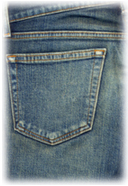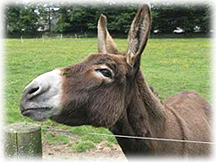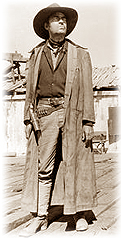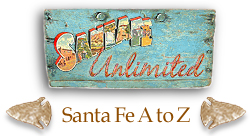|
|||
 Denim (or Blue Jeans) Denim (or Blue Jeans)Denim originated independently in France and India, and was traditionally dyed with natural indigo dye. Trousers made from the material were produced in a town near Turin, Italy, and were popularized in the 16th century. Pants made of this material were originally worn by sailors, who required durability in their uniforms. The jeans would be dragged behind ships in fishing nets to wash them, where exposure to salt water and the sun would eventually bleach them white. In the 1850s, a dry goods merchant named Levi Strauss sold blue jeans under the Levi name in the mining towns of Northern California. A local tailor, who frequently made repairs to miners' jeans, had the idea to reinforce the pocket corners and waistband of the jeans with copper rivets. He approached Strauss with the idea of going into business together, and the modern blue jean was born. Popular with the Cowboy and all western-style enthusiasts, Levi (and other later brand name) blue jeans are almost synonymous with the American Southwest and its easy-going lifestyle. (~Aimee) Desert (see High Desert) Desert terrain may consist of mountains, a basin surrounded by mountains, or a high plain. Many desert areas were once lake and sea beds that show the effect of erosion and soil deposits carried there by rivers. In many deserts, the fossils of ancient sea creatures and fish can be found in rock formations.  Wind also helps shape the desert terrain by blowing great clouds of dust and sand that bite into rock, sometimes sculpting it into strange and magnificent shapes. “Dust devils,” columns of dust that spin over the desert landscape, are carried by whirlwinds. Some dust storms produce clouds thousands of feet high. Desert soils tend to be coarse, light-colored, and high in mineral content. They contain little organic matter, because there is so little vegetation. And desert soils offer little help to plant life, since they lack the nutrients provided by decaying vegetation and are easily blown away, exposing plant roots to the dry air. Some deep-rooted plants can exist on rock, however, where moisture accumulates in cracks. Other plants remain dormant during the driest periods, thriving and blooming after brief rains. Succulents, including cacti (cactus), retain water during rainy periods to sustain them during dry periods. (~Aimee) Dixon Dixon is a village of approximately 1,500 people located in the Embudo Valley, about 20 miles south of Taos, New Mexico on the River Road to Taos. Set on the banks of the Embudo River, its temperate climate and well established acequia system have made Dixon a significant grape and fruit growing area with the largest population of organic farmers in the state. Over the years, many artists and crafts people have also made Dixon their home, resulting in the creation of the Dixon Studio Tour in 1982. (~Aimee)  Donkey (see Burro) Donkey (see Burro)A domesticated member of the horse family, the donkey's wild ancestor is the African Wild Ass. Males are called jacks and females jennies. Offspring have the same names as horses (i.e., foal for either sex under one year, and colt and filly for males and females who are over one year old). Different species within the Equidae, or horse family can interbreed, however, their offspring are almost always sterile. A mule is the offspring of a jack (male donkey) and a mare (female horse). Though rarely successful, the offspring of a stallion (male horse) and a jenny (female donkey) is a hinny. The Spanish brought burros to North America, where they quickly became the chosen beast of burden of early prospectors, due to their sure-footedness. While many use the terms donkey and burro interchangeably, others call the smaller Mexican descendants burros, and their larger cousins, imported directly from Europe, donkeys. Burros which were abandoned or ran away gave rise to feral burros in the Western range lands. Fortunately, these animals are now protected in New Mexico, where they are considered to be a living legacy. During drought conditions, herds are at risk, and are routinely thinned to preserve grazing. Roundups remove a percentage of the feral burros, which are then auctioned to the public. Wild burros are clever and curious, making excellent pets when treated well and trained properly. Once trust has been established, they greatly enjoy the company of humans. (~Aimee)  NOTE: See our special feature on the Burro in Plants & Wildlife NOTE: See our special feature on the Burro in Plants & WildlifeDuster The original dusters were full-length, light-colored canvas or linen coats worn by horsemen to protect their clothing from trail dust. These dusters were typically slit up the back to hip level for ease of wear on horseback. At the turn of the 20th century, both men and women wore dusters to protect their clothes when riding in open motorcars on dirt roads. Western horsemen's dusters gained renewed popularity in the late 20th century, primarily through the J. Peterman catalog, and are now a standard item of Western wear. They figured little in Western films, until Sergio Leone re-introduced them in his movies “The Good, the Bad, and the Ugly” and “Once Upon a Time in the West.” The duster was also worn by some of the characters in the movie “Silverado” and the TV mini-series “Lonesone Dove.” Pictured top to bottom: 1} Pocket on a pair of worn blue jeans; 2} The New Mexican High Desert; 2} Happy donkey on a New Mexican farm; 3} The Old West duster coat |
|||
Home | Food | Lodging | Merchants | Services | Real Estate | Art & Galleries | Entertainment | Recreation Ski Areas | Mind-Body-Spirit | Santa Fe Information | Local Color | Canyon Road | The Turquoise Trail | Santa Fe Plaza The Pueblos | Scenic Beauty | Day Trips | Chili | Special Events | Santa Fe History | Multicultures | Museums High Road to Taos | The Wild West | Churches | Plants & Wildlife | Santa Fe Railyard | Turquoise | Architecture Fiesta | Indian Market | Spanish Market | Zozobra | Features | About Us | Get Listed! | Santa Fe Unlimited Trading Post Photo of the Week | Link of the Month | Testimonials | Santa Fe Webcams | Santa Fe Weather Santa Fe A to Z | Movie Locations | Santa Fe Unlimited Guestbook | Sitemap | Contact Us | Taos Unlimited All original graphics and content of this website, unless otherwise indicated, are copyright © 2006-2011 Santa Fe Unlimited and may not be reproduced in any fashion. |
|||

